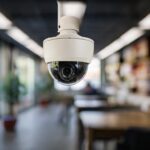Self-storage as an industry has exploded in recent years as both businesses and families seek offsite spaces to consolidate possessions. However, the unattended nature of storage facilities unfortunately also draws theft by tenants abusing access or external criminals. As an owner, protecting customers’ often irreplaceable belongings stored in your facility is a legal and ethical imperative. Reports of break-ins, vandalism, and property damage can quickly sink reputations and bottom lines.
Let’s review some of the proactive, multi-layered self-storage security standards combining physical access barriers, screening procedures, security personnel and surveillance technology. When woven together, these defenses create a formidable web of protections tuned precisely to risks in this sector.
We will overview building exterior measures then inspection protocols and finally turn to cutting-edge video analytics and monitoring essential for storage facilities. Follow these in-depth guidelines to reinforce your buildings, hire qualified guards if able, and leverage automation and storage facility security cameras. Adopting even a few of the policies covered will visibly signal attention to asset security, providing tenants peace of mind.
Hardening Your Facility’s Outer Shell with Gates, Lighting and Alarms
The first requirement for any self-storage security plan are access controls selectively limiting who enters the premises and especially rental areas. Sturdy perimeter fencing upwards of 8ft tall should fully surround facilities, with difficult-to-climb exterior materials like metal bars or preventing grip points. Top fencing with inclined barbed wire presenting another obstacle for individuals attempting to scale walls or gates via handholds.
Entry and exit points need barriers equally discouraging unwanted passage. Install heavy-duty mechanical gates or bollards paired with keycard, pin code or other access control readers so only staff and verified customers transition through. Electrified locks also add greater security. Match durable pedestrian access doors to gate and wall constructions – solid metals with shielded locks and tamper-proof hinge pins. Propping open policies, frequent re-keying, disguising backdoors and other fundamentals apply as well.
Another baseline layer are alarm systems wired at critical entry points, storage unit blocks, rear perimeters or vulnerable utility boxes. Motion detectors with 120+db sirens create attention, deactivate interlocks if triggered out of hours and alert remote owners an incident may be unfolding. LED floodlights eliminate dark corners around buildings and parking areas criminals exploit, especially bathing exterior fences and wall faces. Notice and deterrence nullify most opportunistic intrusion attempts.
Vetting and Monitoring Customers with Screening, Registration and Inspections
Hard boundaries notwithstanding, storage users themselves as “insiders” are the most common source of theft and property damage according to law enforcement. Owners therefore need thorough customer qualification procedures prior to rental sign-off. Enforce strict policies checking IDs against provided personal details, performing criminal background reviews where possible, acquiring vehicle information and inspecting storage contents for hazmat risks during move-ins. Maintaining current occupant registers also supports tracing culprits later if needed.
Ongoing unit inspections and inventory audits must reinforce intake diligence over the rental term, ensuring tenants are not modifying spaces illegally or moving unpermitted assets onsite imperiling other occupants. Conduct unannounced visits at randomized intervals, documenting unit contents against initial declarations. Having occupants install their own secondary door locks also shifts liability while hampering concealed access. Note storage firms bear responsibility for preventing foreseeable internal theft – taking these tenant screening and oversight steps helps satisfy that standard.
Leveraging Guard Personnel to Put Eyes on At-Risk Areas
Even robust exterior access controls and tenant monitoring cannot provide total facilities oversight around the clock. This gap is where trained on-premise security guards prove invaluable to self-storage protection plans. Personnel presence establishes an on-the-ground, human layer of theft detection and suspicious activity intervention not possible otherwise. Guards monitor site activity, question unknown parties, greet customers providing an additional verification check before unit access and deter opportunists simply by being visible.
Have personnel conduct rotating exterior patrols including building perimeter walks, observing rental aisles through windows, and scanning rooftops for signs of intrusion or tampering. Conduct regular parking lot passes checking for extended or unauthorized vehicle presence. Following security rounds best practice, guards should carry communications devices, maintain logs of observations and report anomalies to owners in real time. Make random schedule rotations to avoid predictability. Posted notices that guards fulfilling these descriptions are on duty 24/7 magnifies perceptions of oversight even during off hours. Well utilized personnel strongly reinforce storage security.
Installing Premium Door Locks as Unit Entry Barriers
In addition to screening customers and monitoring activities in common areas, individually locking down storage units themselves is critical. Provide the highest grade padlocks on all external unit doors as the last line of defense before customer belongings, ones resisting picking, cutting, prying or copying keys. Seek chains or deadbolts exceeding 10mm thickness with reinforced strike plates, protected key channels and dual locking bars on larger roll-up doors. Apply tamper-proof seals to doors and lock bodies indicating attempts to bypass. Make all locking cores easily replaceable so new tenant assignments or compromises force fast rekeying.
Specify that renters must furnish their own formidable interior locks meeting similar standards to further slow breach efforts. Discouraging forced entry attempts combined with added expense if successful stops 80% of thieves who target convenient opportunities rather than hardened defenses. Sourcing the most formidable door and locking fixtures inhibits storage unit robberies.
Installing Camera Systems with Smart Detection Capabilities
The last pillar of a comprehensive self-storage security plan is an integrated video surveillance system with cameras covering all exterior and interior zones frequented by customers or personnel. Modern digital cameras have become indispensable for their 24/7 monitoring capabilities, capturing incidents even when guards are off shift and sites are unattended overnight or weekends. Maintained recordings also provide invaluable evidence supporting liability claims or police investigations later if needed, where eyewitnesses are unavailable.
Equally important, current security cameras apply video analytics like motion mapping, activity analysis and machine learning algorithms to automatically detect aberrant events in real time. AI-powered systems learn expected patterns over time, sending instant alerts to owners and operations teams when previously unseen behaviors occur, such as Testing fence integrity. Flagging anomalies remotely allows rapid guided response by owners viewing feeds live offsite. Upgrading legacy equipment to newer smart recording solutions should be strongly considered.
Applied in combination, robust surroundings locks, stringent customer policies, frequent walkthroughs by uniformed guards and intelligently monitored camera networks create overlapping zones that mutually reinforce storage facility protections. This “defense in depth” doctrine adapts key concepts from physical security fields into a commercial self-storage environment cost-effectively, projecting security commitment to prospective tenants as an additional benefit.
Protect Your Facility with Live Patrol’s Storage Facility Security Camera Solutions
As detailed throughout this article, self-storage sites face unique property risks from all angles, including vulnerabilities at perimeters, around tenant accesses, and overnight when unoccupied. Owners must secure facilities in depth across physical and virtual layers to combat thieves targeting valuables they believe are accessible. Live Patrol recognizes managing security can still overburden limited staff and budgets.
Our innovative monitoring firm provides tailored oversight options that enforcement technology, personnel and even robust locks cannot deliver alone. Specifically, Live Patrol couples intelligent, self-learning surveillance camera systems with 24/7 professional monitoring from our central response centre. Certified analysts instantly identify suspicious incidents and trespassing the moment algorithms flag them using license plate and facial recognition.
We coordinate real-time warnings via site speakers, dispatch guards proactively, or contact authorities based on established protocols – capabilities unmatched by traditional solutions. Daily system health checks validate continued protections, with guaranteed assistance if ever needed.
Keep your facility, tenants and community safe while focusing resources into your core business. Learn more about Live Patrol’s advanced storage safety offerings by contacting our team about storage facility security cameras.


